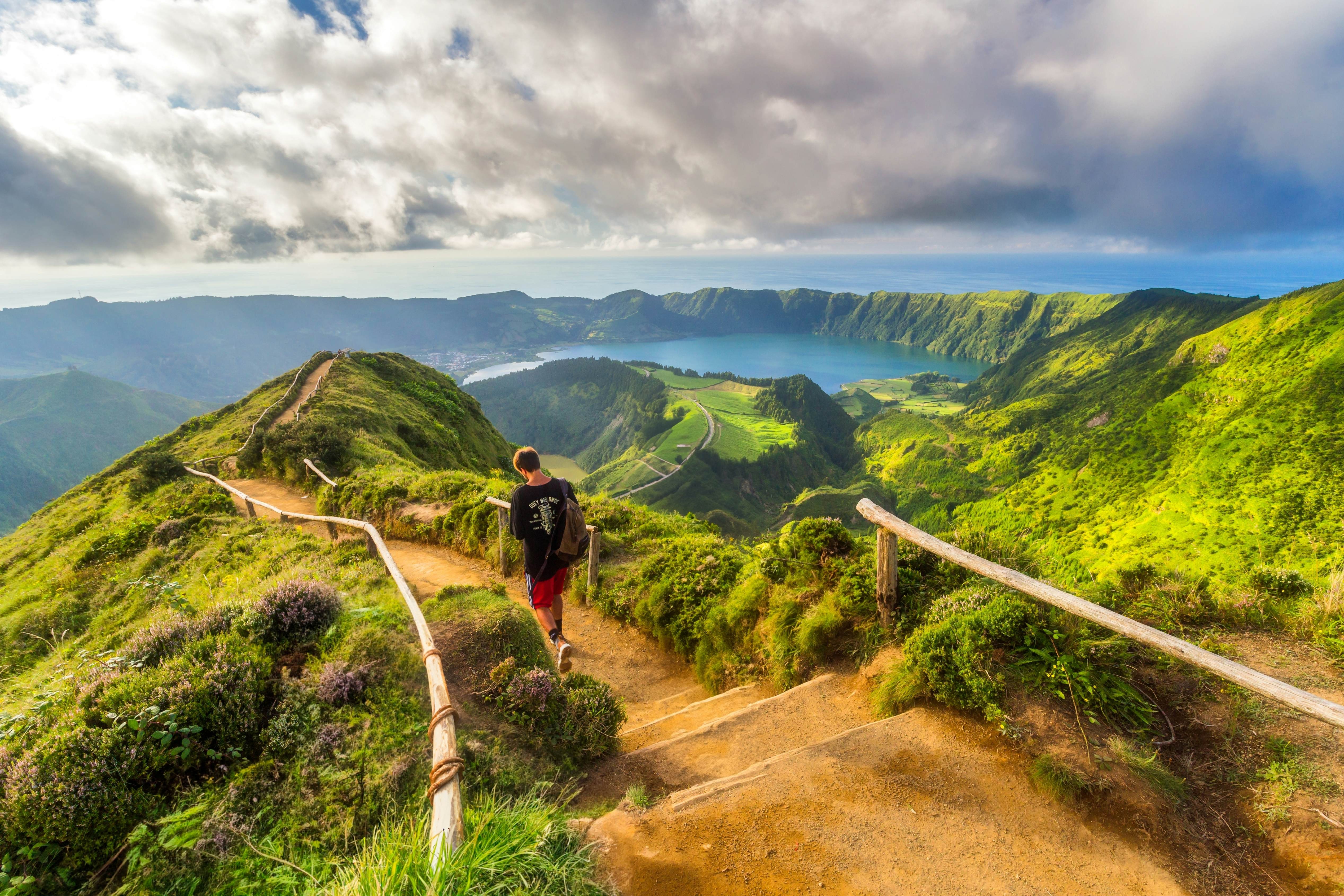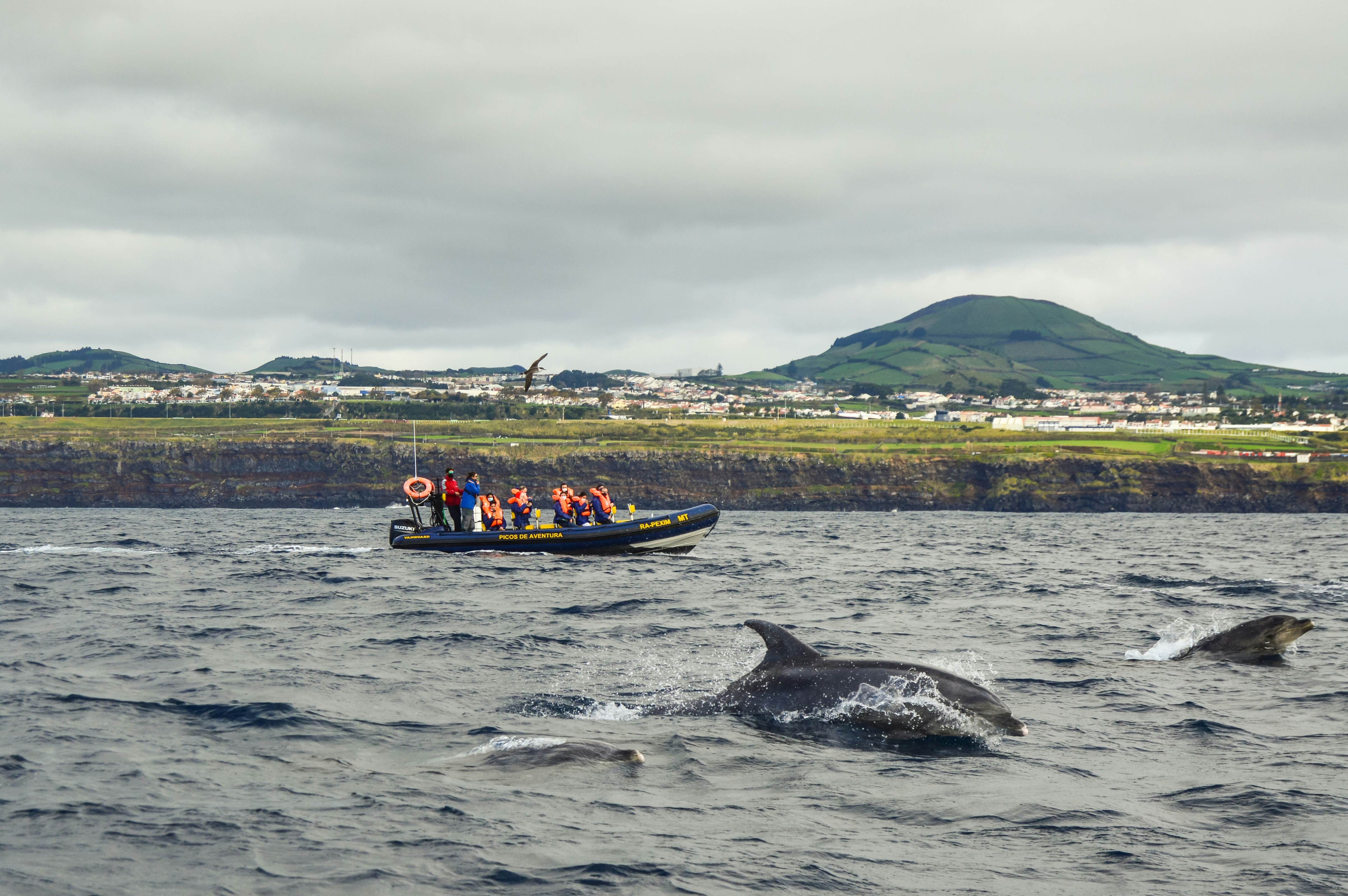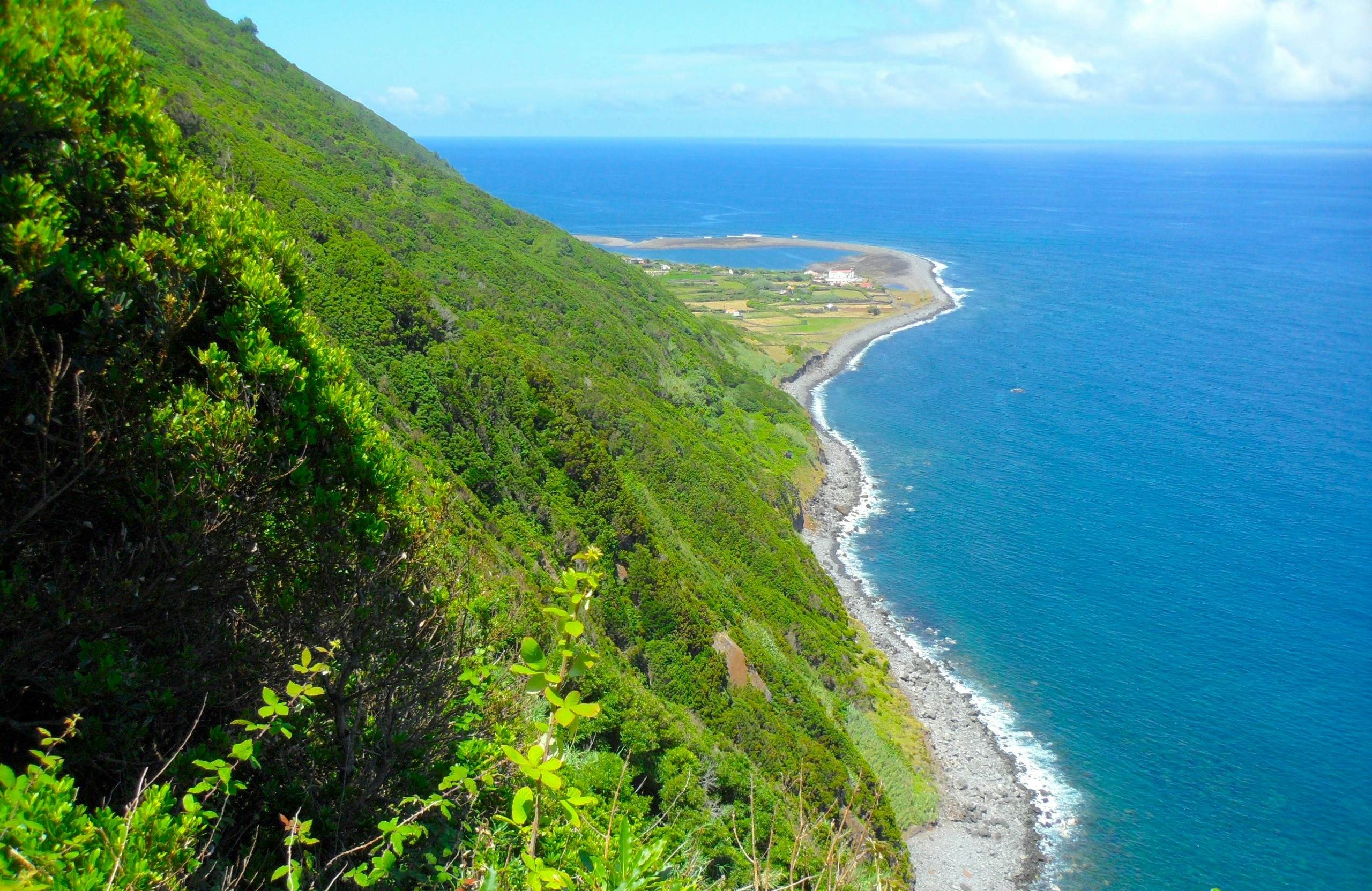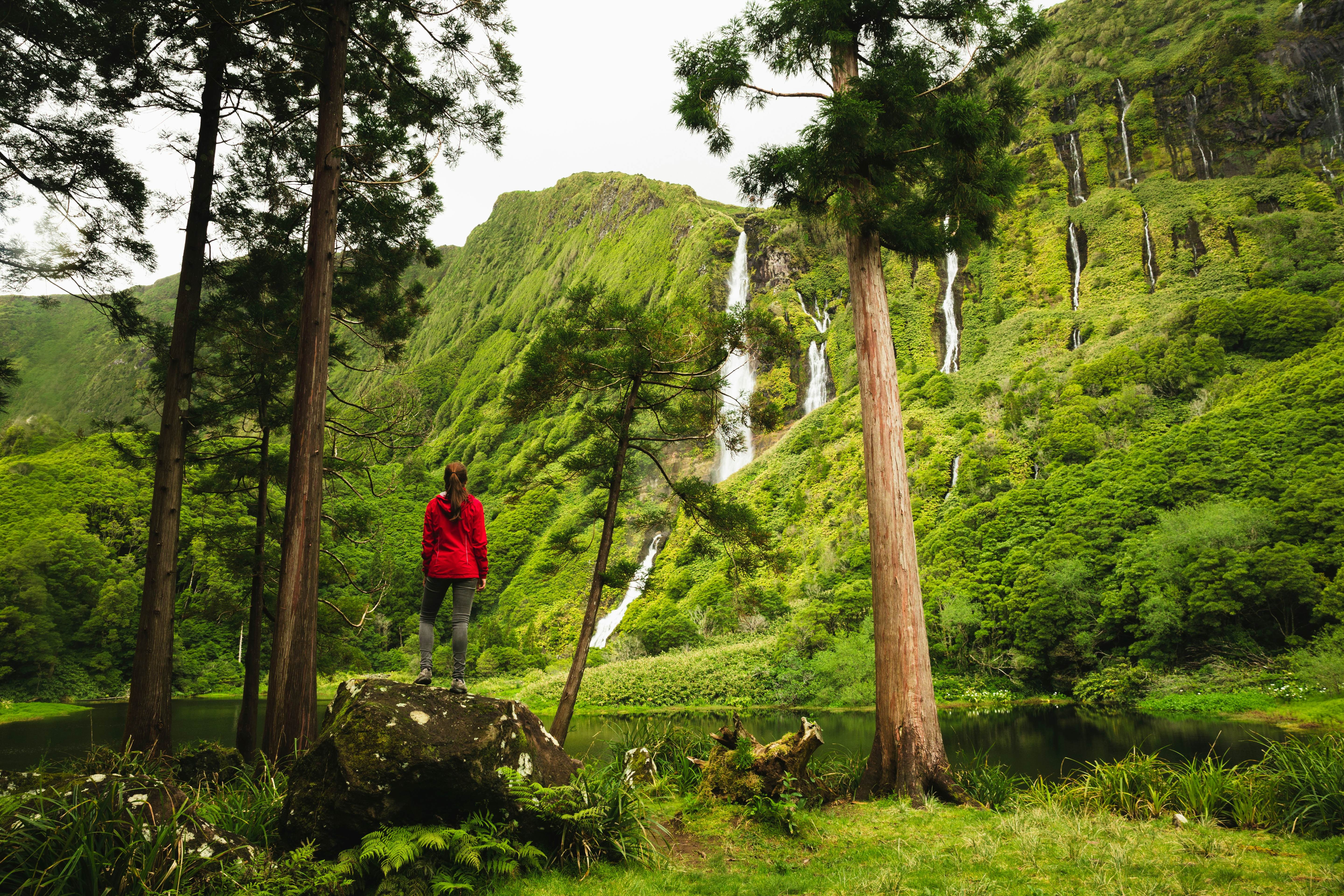Azores Islands Tourism offers a unique blend of natural beauty and cultural experiences, making it an unforgettable destination. Let SIXT.VN guide you through this stunning archipelago with seamless travel solutions, ensuring a smooth and enriching experience. Discover the hidden gems of these captivating islands, from volcanic landscapes to charming coastal villages, all while enjoying convenient services.
1. When Is the Best Time to Visit the Azores Islands?
The Azores Islands are a year-round destination, but the best time to visit depends on your preferences and budget. If you want to travel during the low season, consider shoulder seasons such as spring (April-May) or fall (September-October) when there are fewer crowds and the weather is still pleasant. However, if you want to go to the beach and enjoy water sports, summer (June-August) is the ideal time to visit. Remember to pack for all types of weather, as it can change quickly!
- Summer (June-August): Warmest temperatures, ideal for swimming and sunbathing. Expect more crowds and higher prices.
- Shoulder Seasons (April-May & September-October): Pleasant weather, fewer crowds, and more affordable prices.
- Winter (November-March): Cooler temperatures and higher chance of rain. Fewer tourists, but some outdoor activities may be limited.
2. How Can I Easily Reach the Azores Islands?
Reaching the Azores Islands is convenient, especially with well-connected air travel options. São Miguel is the primary hub, offering international flights from the USA, Canada, and Europe. If direct flights are unavailable, connecting via Lisbon or Porto in mainland Portugal is a great option. Once on São Miguel, SATA Azores Airlines provides internal flights to the other islands.
- International Flights: Ponta Delgada Airport (São Miguel) receives flights from major cities.
- Connecting Flights: Lisbon and Porto offer frequent flights to the Azores.
- Internal Flights: SATA Azores Airlines connects all nine islands.
- Azores Air Pass: SATA offers a special rate for visiting up to three islands.
- Ferries: Atlanticoline serves several islands, but schedules can be affected by weather.
3. What Is the Best Way to Get Around the Azores Islands?
 A small red car drives by a bank of blue hydrangea bushes in Sete Cidades, São Miguel, Azores, Portugal
A small red car drives by a bank of blue hydrangea bushes in Sete Cidades, São Miguel, Azores, Portugal
Renting a car is the best way to explore the Azores Islands. It gives you the freedom to see more at your own pace. SIXT.VN can help you arrange a rental car, ensuring a hassle-free experience from airport pickup to island exploration. For inter-island travel, consider taking your rental car on the ferry between islands like Pico, Faial, and São Jorge.
- Rental Car: Offers flexibility and access to off-the-beaten-path locations.
- Public Buses: Available on most islands, except Corvo.
- Ferries: Allow you to bring your rental car between certain islands.
- Walking: Essential for experiencing the islands’ natural beauty.
4. How Much Time Should I Allocate for Azores Islands Tourism?
The ideal duration for your Azores Islands tourism depends on what you wish to experience. For a first-time visit focusing on São Miguel, five days should suffice. However, to truly appreciate the diversity of the archipelago, plan for two to three weeks to explore multiple islands. Each island offers unique landscapes and activities, making an extended trip worthwhile.
- São Miguel: 5 days is ideal for a thorough introduction to the largest island.
- Multi-Island Trip: 2-3 weeks to fully experience the archipelago’s diversity.
5. What Are the Top Activities for Azores Islands Tourism?
 A hiker with a backpack walks down a dirt path following the ridge of the hill overlooking a volcanic lagoon. The surrounding hillsides and cliffs are green and lush.
A hiker with a backpack walks down a dirt path following the ridge of the hill overlooking a volcanic lagoon. The surrounding hillsides and cliffs are green and lush.
Azores Islands tourism offers a variety of activities for nature lovers and adventure seekers. Hiking is a must, with trails leading to volcanic lagoons and waterfalls. Climb Mount Pico, Portugal’s highest point, for breathtaking views. Explore volcanic landscapes, relax in thermal springs, and enjoy whale-watching tours. Don’t miss the Gorreana Tea Factory, Europe’s oldest tea plantation.
5.1. Hiking in the Azores Islands
The Azores are a hiker’s paradise, offering trails for all skill levels. According to VisitAzores.com, the islands boast numerous well-maintained trails that showcase the natural beauty of the archipelago.
- Lagoa do Fogo Trail (São Miguel): A moderate hike offering stunning views of the volcanic crater lake.
- Ponta da Barca Trail (Graciosa): An easy coastal walk with beautiful ocean vistas.
- Caldeira do Faial Trail (Faial): A challenging hike around the rim of the Faial caldera.
5.2. Volcanic Exploration
The volcanic nature of the Azores has shaped its unique landscapes and history. At São Miguel, indulge in a rejuvenating experience at iron-rich thermal springs, where the waters are warmed by the island’s inner depths. According to a study published in the Journal of Volcanology and Geothermal Research, the geothermal activity in the Azores is among the most intense in Europe, providing unique opportunities for scientific research and tourism.
- Furnas (São Miguel): Witness the traditional cozido dos Açores cooked underground by volcanic heat.
- Capelinhos Volcano (Faial): Explore the site of the 1950s eruption and visit the interpretative center.
- Natural Pools (Terceira and São Jorge): Enjoy volcanic rock-heated pools carved by the Atlantic.
5.3. Whale Watching in the Azores Islands
 People in an inflatable boat watch dolphins surface off the water just off the coast of an island with rocky cliffs along its shore.
People in an inflatable boat watch dolphins surface off the water just off the coast of an island with rocky cliffs along its shore.
The Azores are one of the world’s best destinations for whale watching. Many species of whales and dolphins pass through the waters around the Azores during their migration.
- São Miguel: Join a whale-watching tour from Ponta Delgada for a chance to see whales and dolphins.
- Pico: Visit the Whale Museum in Lajes do Pico to learn about the history of whaling in the Azores.
5.4. Tea Plantation Tour
 Front of Fábrica de Chá Gorreana (Gorreana Tea Factory), São Miguel, Azores, Portugal
Front of Fábrica de Chá Gorreana (Gorreana Tea Factory), São Miguel, Azores, Portugal
Visiting the Gorreana Tea Factory on São Miguel provides a unique cultural experience. The factory offers free tours of the plantation and museum.
5.5 Tranquility in Azorean Fajãs
 View of Fajãs da Caldeira along the hiking route Serra do Topo to Fajãs dos Cubres, São Jorge, Azores, Portugal
View of Fajãs da Caldeira along the hiking route Serra do Topo to Fajãs dos Cubres, São Jorge, Azores, Portugal
Escape to the tranquil fajãs, small coastal villages nestled by cliffs, offering a peaceful retreat.
- Fajã da Caldeira de Santo Cristo (São Jorge): Accessible by hiking or quad bike, this remote village offers a serene escape with limited connectivity.
- Unplug and Relax: Enjoy kayaking in the lagoon and tasting local clams at O Borges restaurant.
6. What Should I Budget for Azores Islands Tourism?
The Azores Islands cater to all budgets, from luxury hotels to local homestays. Your car rental will likely be your biggest expense, especially during high season, so book in advance. According to recent data, the average daily costs are as follows:
| Expense | Average Cost |
|---|---|
| Four-star hotel room (for two) | €150 (US$158) |
| Dormitory room in a hostel | €45 (US$47) |
| Self-catering apartment | €100 (US$106) |
| Car rental (per day) | €35 (US$37) |
| Furnas stew (for two) | €30 (US$31.50) |
| Coffee | €1 (US$1.05) |
| Beer | €1.50 (US$1.58) |
| Entrance to hot springs | €8 (US$8.40) |
7. What Should I Pack for Azores Islands Tourism?
 A woman looks at waterfalls on a hike in Flores, Azores, Portugal
A woman looks at waterfalls on a hike in Flores, Azores, Portugal
Given the variable weather and opportunities for outdoor adventures, pack accordingly. Essential items include a light rain jacket, a breathable fleece layer, waterproof trekking boots, and a backpack.
- Clothing: Layers are essential due to the changing weather conditions.
- Footwear: Waterproof trekking boots are recommended for hiking.
- Accessories: A backpack, rain jacket, and sunscreen are essential.
8. How Can I Interact With Nature Safely During Azores Islands Tourism?
Exploring the Azores’ volcanic craters and lagoons is a memorable experience, but it’s essential to respect the environment. Adhere to marked trails to protect vegetation and prevent soil erosion. Follow safety signs, especially around lagoons, and be aware of changing weather conditions.
- Stay on Marked Trails: Protect vegetation and prevent soil erosion.
- Follow Safety Signs: Adhere to warnings at lagoons and other natural sites.
- Check the Weather: Be prepared for sudden changes, especially in higher areas.
9. What Unique Cultural Experiences Can I Enjoy in the Azores?
The Azores Islands offer several unique cultural experiences that provide insight into the local traditions and heritage. Consider visiting local festivals, exploring historical sites, and savoring Azorean cuisine.
9.1. Local Festivals
Participate in the vibrant local festivals that showcase the traditions and culture of the Azores. According to the Azores Tourism Association, these festivals provide an authentic glimpse into the island’s heritage.
- Sanjoaninas Festival (Terceira): One of the largest secular festivals in the Azores, featuring parades, concerts, and bullfights.
- Festa do Senhor Santo Cristo dos Milagres (São Miguel): The biggest religious festival in the Azores, marked by processions and religious ceremonies.
- Semana do Mar (Faial): A week-long maritime festival with sailing regattas, concerts, and cultural events.
9.2. Historical Sites
Explore the rich history of the Azores by visiting its well-preserved historical sites. UNESCO recognizes Angra do Heroísmo on Terceira Island as a World Heritage site.
- Forte de São Sebastião (Terceira): A 16th-century fortress that played a significant role in the island’s defense.
- Convento de Nossa Senhora da Esperança (São Miguel): A beautiful convent known for its religious art and serene atmosphere.
- Capelinhos Lighthouse (Faial): A historic lighthouse that witnessed the volcanic eruption of 1957-58.
9.3. Azorean Cuisine
Indulge in the unique flavors of Azorean cuisine, which combines fresh local ingredients with traditional cooking methods. According to local chefs, the cuisine is a reflection of the island’s volcanic soil and ocean surroundings.
- Cozido das Furnas (São Miguel): A traditional stew cooked underground using volcanic heat.
- Fresh Seafood: Enjoy a variety of freshly caught fish and seafood dishes.
- Queijo São Jorge (São Jorge): A semi-hard cheese with a distinctive flavor, aged for several months.
10. What Are the Lesser-Known Gems of the Azores Worth Visiting?
Venture beyond the popular spots to discover the Azores’ hidden gems. These lesser-known locations offer unique experiences and a chance to connect with the islands’ natural beauty away from the crowds.
10.1. Poço do Bacalhau Waterfall (Flores)
Discover the stunning Poço do Bacalhau Waterfall on Flores Island. Tucked away amidst lush greenery, this hidden gem offers a serene and picturesque escape. The waterfall cascades into a crystal-clear pool, perfect for a refreshing dip surrounded by untouched nature.
10.2. Vila do Corvo (Corvo)
Experience the charm of Vila do Corvo, the only town on the smallest Azorean island. With its cobblestone streets, traditional houses, and friendly locals, this hidden gem offers a glimpse into a simpler way of life. Explore the town on foot, visit the local church, and enjoy panoramic views of the surrounding landscape.
10.3. Ilhéu de Vila Franca do Campo (São Miguel)
Explore the volcanic islet of Vila Franca do Campo, located just off the coast of São Miguel. This natural wonder features a stunning circular bay, formed by a submerged volcanic crater. Accessible by boat, the islet offers excellent snorkeling and swimming opportunities in its clear, protected waters.
Planning your Azores Islands tourism adventure has never been easier with SIXT.VN. We offer comprehensive travel solutions, including airport transfers, hotel bookings, and tailored tour packages. Experience the convenience and reliability of our services as you explore the Azores.
Don’t let travel challenges hold you back from experiencing the beauty of the Azores. With SIXT.VN, you can overcome language barriers, secure reliable transportation, and enjoy seamless travel arrangements. Contact us today to start planning your unforgettable journey to the Azores Islands.
Address: 260 Cau Giay, Hanoi, Vietnam
Hotline/Whatsapp: +84 986 244 358
Website: SIXT.VN
FAQ About Azores Islands Tourism
- Is the Azores Islands tourism expensive?
The Azores can cater to various budgets. Accommodation ranges from budget-friendly hostels to luxury hotels, and dining options vary in price. - What is the weather like in the Azores?
The Azores have a mild, subtropical climate. Temperatures range from 12°C (54°F) in winter to 26°C (79°F) in summer. - Do I need a visa to visit the Azores?
As part of Portugal, the Azores follow Schengen Area visa policies. Check visa requirements based on your nationality. - What language is spoken in the Azores?
Portuguese is the official language. English is widely spoken in tourist areas. - Is it safe to drink tap water in the Azores?
Tap water is generally safe to drink, but bottled water is also readily available. - What currency is used in the Azores?
The Euro (€) is the currency used in the Azores. - Are credit cards widely accepted?
Credit cards are accepted in most hotels, restaurants, and shops, but it’s good to have some cash for smaller establishments and markets. - What is the best way to stay connected to the internet?
Most hotels and cafes offer free Wi-Fi. Local SIM cards with data plans are also available. - Are there any health precautions I should take?
No specific vaccinations are required for the Azores. Standard travel health precautions apply. - What are some local customs I should be aware of?
The Azoreans are generally friendly and welcoming. Politeness and respect for local customs are appreciated.



